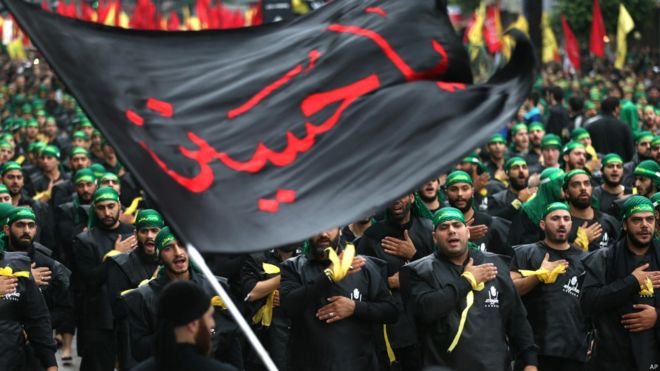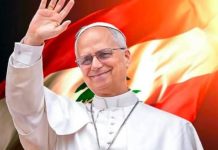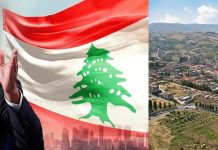Understanding Hezbollah’s history as a ‘proxy of Iran’
Tony Duheaume/ Al Arabiya English/January 07/ 2017
During the early days of the Iranian regime, one man who had spent his entire career in the IRGC, who was devoutly committed to his military role as senior commander, had stood out more than most amongst his peers as a resolute leader, and this man was Hossein Dehghan.
After Israel had invaded Lebanon in 1982, Dehghan, who was dedicated to the Iranian Revolution, and would later become Hassan Rouhani’s defence minister, left Tehran for active service there. After arriving in Lebanon, Dehghan worked alongside other military commanders to establish a fighting force that would be powerful enough to hit back at the Israeli invader, which eventually named itself Hezbollah (Party of God).
It was during his stint in Lebanon, Dehghan received orders from Tehran to carry out an attack against the multinational peacekeeping forces stationed in Beirut. On October 23, 1983, under the watchful eye of Dehghan, an Iranian suicide bomber named Ismalal Ascari drove a 19 ton Mercedes explosively-laden truck, containing an equivalent of six tons of TNT, through a barbed wire fence, and travelling past two guard posts, he trundled across a courtyard, driving the truck into the lobby of the 1st Battalion, 8th Marine Regimental Battalion Landing Team barracks in Beirut, situated at Beirut International Airport.
The barracks housed US Marines that were part of a multi-national peacekeeping force, who were sleeping at the time, and as a result of the devastating blast, the four-story building housing them had collapsed into a heap of rubble, killing 220 marines, 18 sailors and three soldiers.
Then minutes later, before the dust had even settled, a second truck bomb was driven into the underground car park of a separate building, in the Ramlet al-Baida area of West Beirut, which housed French paratroopers, and the resulting blast killed 58 soldiers of the 1st Parachute Chasseur Regiment. From the amount of damage the bombs had caused, it was estimated that the explosives were equivalent to 9,525 kg (21,000) of TNT.
At the time of the attacks, a relatively unknown group calling itself “Islamic Jihad” had claimed responsibility for the bombings, but right from the start the Americans suspected the fledgling terror group Hezbollah had committed the atrocities, carried out at the behest of Iran and Syria.
Pulling strings
Hezbollah didn’t even admit to its existence until 1985, in its early years it was suspected of using the alias of Islamic Jihad, and was run by Imad Mughniyeh, who became notorious for the amount of attacks he eventually carried out in both the Middle East and the West, during his term as commander of Hezbollah. While leading the terror group, Mughniyeh was often spotted in both Iran and Syria, and was bankrolled by the mullahs, until his assassination by a car bomb in Syria on February 12, 2008.
During the 1980s, with the Quds Force still pulling its strings, Hezbollah continued to be a subservient proxy of Iran, and the regime often used it to carry out terrorist attacks, which allowed the mullah leadership the opportunity to claim plausible deniability to. As time went on, Hezbollah became a crucial wing of Iran’s overseas terror capabilities, with it having become obvious to the regime at an early stage, that by using its proxies to carry out the operational side of its attacks on foreign soil, it would leave its own military forces clear of any blame through lack of evidence, and the more the mullahs were getting away with mass murder, the bolder they became.
As acts of terror continued across the globe throughout the 1980s, a series of atrocities were placed at the door of Hezbollah, which included the 1983 hijacking of a TWA airliner, a series of fatal bombings in Paris killing 12 people, a series of kidnapping, tortures and murders of US, citizens in Lebanon throughout the 1980s; on a list that was forever growing during that era.
As far as Hezbollah’s terrorist activities were concerned, not even the likes of Hassan Rouhani, Iran’s current “moderate” president, could claim that he was exempt from blame. Rouhani himself was tainted by the deaths of dozens of people, as during the 1990s, when he was national security advisor to the then President of Iran, Hashemi Rafsanjani, two very devastating terrorist attacks took place, instigated by the Qods Force, both of which he was certain to have been linked to.
The first of these attacks took place March 17, 1992, when Rafsanjani was alleged to have ordered the truck bombing of the Israeli embassy in Buenos Aires, when a 1985 Ford pickup truck containing approximately 225-340kg of TNT exploded near the front entrance of the embassy, destroying much of the building’s facade, killing twenty-nine people. Then two years later, on July 18, 1994, in the same city, the bombing of the Argentine-Israeli Mutual Association (AMIA) took place, in which 85 people lost their lives, and Hezbollah claimed full responsibility for both terror attacks.
In the Jewish Community centre attack, a Renault Trafic van driven by Ibrahim Hussein Berro, a 21-year-old Lebanese citizen, and a known operative of Hezbollah, entered a heavily built up commercial area of Buenos Aires, and driving close to the entrance of the Jewish Community Centre, at calle Pasteurr 633, Berro detonated explosives that were packed inside the van.
The bomb was said to have been the equivalent of 300 to 400 kg of TNT, it was composed of ammonium nitrate, combined with aluminium, a heavy hydrocarbon, TNT and nitro-glycerine, and the resulting explosion brought down the front of the building, devastating the inside structure, wrecking buildings within a radius of around 200 metres, killing 85 people, and injuring over 150, many seriously maimed.
Then at a later date, during a press conference on October 25, 2006, Argentine prosecutors Alberto Nisman and Marcello Marquez accused high level Iranian ministers of being behind the 1994 terror attack against the AMIA. But it was claimed that only after the U.S. had applied diplomatic pressure on Argentina, arrest warrants were issued for Hashemi Rafsanjani, Foreign Minister Ali Akbar Velayati, Intelligence Minister Ali Fallahijan and National Security Secretary Hassan Rouhani, for their involvement in the planning of the attack.
Too much on its hands
From a report published on May 29, 2013, the Argentine prosecutor Alberto Nisman issued a 500-page indictment, which also accused Shiite cleric Mohsen Rabbani of supplying logistical support for the AMIA attack, and at the time, although claiming to be a representative of the Ministry of Agriculture of Iran, he was in fact a leading member of Ayatollah Khomeini’s Intelligence Bureau.
Having originally arrived in Argentina as a tourist in 1983, within a year Rabbani had attained permanent residency, and through the use of three Shiite mosques, all of which were under his control, he was able to brainwash young students, recruiting them to take part in terrorist acts; a process which the Iranian regime is well accustomed to.
The report went on to explain how young recruits from poorer communities in Argentina, were offered payments to help them with their studies, which Rabbani was ordered by the Iranian regime to pay them. Then with his young recruits becoming financially indebted to the Shiite cleric, he was able to persuade them to fly to Iran for training at so-called religious centres, which were in fact IRGC military training facilities.
Then two years later, in 1996, Hezbollah’s role in the Khobar Towers apartment complex bombing in Saudi Arabia was highlighted, in which nineteen US servicemen and one Saudi were killed, and 372 people of various nationalities were wounded. Then following this came the October 2000 attack on USS Cole by al-Qaeda, of which Iran was said to have been involved in, and more recently the October 2011 plot to murder the Saudi ambassador in a New York restaurant. Then during the following year, on January 24, 2012, a three-man terror cell run by Iran was exposed for planning to attack the Israeli ambassador to Azerbaijan.
With much more terrorist activity having taken place that year, 2012 was a busy period for Hezbollah, but now that much of its force is tied up in Syria, aiding its Iranian masters to prop up the Assad regime, it presently has too much on its hands to be a threat elsewhere. But as soon as that war is over, Iran will be once more back in the business of exporting terror, and Hezbollah will be back to its old tricks of dishing it out, a sentiment that has already been echoed by IRGC commanders, threatening future attacks on Bahrain once the Syrian conflict has been settled.





















